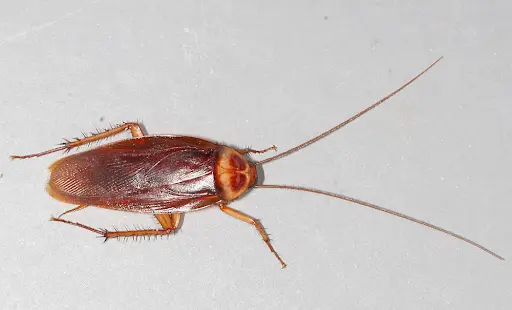How to spot a German roach
There always has to be a worst. When it comes to cockroaches, the worst is the German cockroach.
The German cockroach takes up residency with humans in our homes and businesses -- and they’re the worst species to get into your home for the following upsetting reasons:
- They’re very hard to eradicate because they reproduce rapidly
- They carry medieval diseases like dysentery (and more contemporary ones like salmonella). Under extreme levels of infestation this cockroach can cause allergies, especially in children
- They smell bad
Because they’re so difficult to get rid of, professional pest control is recommended. While other roach varieties aren’t quite as damaging or dangerous, all roach infestations should obviously be addressed. But it’s useful to know what you’re dealing with. So, here’s how you spot a German roach.

From left to right: penny, adult female, adult male, 5th stage nymph, 3rd stage nymph, 1st stage nymph.

("The american cockroach, Periplaneta Americana." by Gary Alpert licensed by CC BY 2.5)
German cockroaches are small, between the size of a dime and a penny, or about a half of an inch long. They move fast and can disappear in cracks and crevices in and around your walls very quickly. Adults are the longest, and they’re the color of a light caramel with two black stripes running horizontally across their backs. Compare that with American roaches, which are bigger and more reddish-colored than tan.
German roaches (thankfully) aren’t the type of cockroaches that can fly. They usually hitch a ride into your home on something you bring in, like groceries or cardboard boxes. But once they’re in, these roaches can spread and reproduce rapidly. Plus these small roaches will eat essentially any organic material they can get their hands on, so if you’re dealing with German roaches you can have a large infestation of ravenous creatures. They are attracted to meats, starches, sugars, and fatty foods. When they can’t find that stuff, they eat household items such as soap, glue, and toothpaste. (And when they can’t find that, they eat … each other.)
How do you know if you have a problem? Well, as the old saying goes, if you see one there’s a good chance there are a hundred more (at least). German cockroaches prefer to live in warm humid places close to food and moisture sources. They are frequently found in kitchen and bathroom environments and are night active so sometimes you won’t see them at all. But sometimes you won’t see them at all. You may encounter droppings, egg sacs, or a musty, oily odor. So, the second you spot something suspicious, it’s time to act.
At Dixon Pest Services, we guarantee your peace of mind. In the midst of a cockroach infestation, you want a pest control service you can trust. Find out more about our promise here.
How to Spot a German Roach in Thomasville, GA
Serving Georgia and Florida